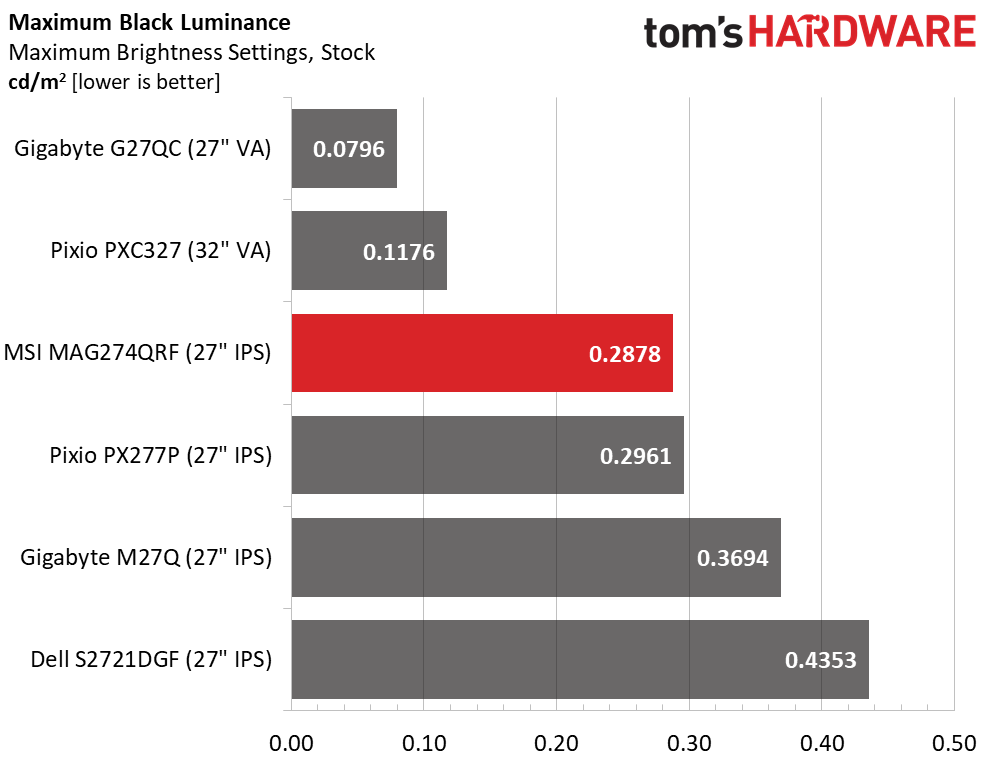Why you can trust Tom's Hardware
To read about our monitor tests in-depth, please check out Display Testing Explained: How We Test PC Monitors. We cover brightness and contrast testing on page two.
Uncalibrated – Maximum Backlight Level
For our benchmarks, we brought in rival QHD, 165Hz monitors, the Gigabyte M27Q, Gigabyte G27QC, Pixio PX277 Prime, Pixio PXC327 and Dell S2721DGF. Two use VA screens, while the rest are IPS.



The MAG274QRF-QD isn’t exceptionally bright, but has sufficient output to satisfy most indoor environments. The Dell and Gigabyte monitors in our comparison top 400 nits, but the rest are slightly less bright than the MSI.
The black level test is no surprise; VA wins the day with minimum thresholds more than twice as dark as the IPS screens. Resulting contrast is an easy win for the G27QC and PXC327, but the MAG274QRF-QD is a standout IPS screen with over 1,157:1 contrast. That’s decidedly above the IPS average.
After Calibration to 200 nits



Our calibration to 200 nits brightness (see our recommended settings on page 1) changes little for the MAG274QRF-QD. Contrast is still over 1,100:1 and still better than the other IPS screens here. The two VA panels offer more than triple the amount of dynamic range, but the MSI has a color advantage with its huge DCI-P3 coverage.
MSI’s ANSI contrast holds strongly at 1,134:1, one of the highest scores we’ve recorded for an IPS monitor. Its panel quality is top-notch with a well-fitted grid polarizer that not only ensures excellent intra-image contrast but a sharp picture overall. It doesn’t get much better for IPS fans.
Get Tom's Hardware's best news and in-depth reviews, straight to your inbox.
Current page: Brightness and Contrast
Prev Page Features and Specifications Next Page Grayscale, Gamma and Color
Christian Eberle is a Contributing Editor for Tom's Hardware US. He's a veteran reviewer of A/V equipment, specializing in monitors. Christian began his obsession with tech when he built his first PC in 1991, a 286 running DOS 3.0 at a blazing 12MHz. In 2006, he undertook training from the Imaging Science Foundation in video calibration and testing and thus started a passion for precise imaging that persists to this day. He is also a professional musician with a degree from the New England Conservatory as a classical bassoonist which he used to good effect as a performer with the West Point Army Band from 1987 to 2013. He enjoys watching movies and listening to high-end audio in his custom-built home theater and can be seen riding trails near his home on a race-ready ICE VTX recumbent trike. Christian enjoys the endless summer in Florida where he lives with his wife and Chihuahua and plays with orchestras around the state.
-
JoBalz ReplyKridian said:$562!? (NewEgg)
muaaahahahahahaaaaa!
I was just looking at other gaming monitors that use Quantum Dot technology displays. This one is one of the least expensive listed as using this tech. -
samopitam Is standard calibration using something like Xrite i1display calibrator enough to decrease the oversaturation and gamma of this monitor to a normal, more natural level while still covering a big percentage of the AdobeRGB gamut?Reply
When using such a calibrator (using either its own or displayCAL software) will every program then automatically use the new lower saturation level? I have no experience with calibration devices so I am just worried about color accuracy and the stated problem that colors will be oversaturated and therefore false all the time. This monitor will be used with both Mac and PC for print and web design. I'm not sure if this software just creates an ICC profile that you can choose system-wide in OS and then change easily to an ICC with more saturation, or if it does something more.
I'm interested in natural saturation levels until a project comes when I will have the need to see more of the color gamut in a graphics program. Is then all that is necessary to choose an AdobeRGB ICC profile in a graphics program like Adobe to view more colors or will the monitor calibration that lowered the saturation prevent you from ever seeing those colors unless you recalibrate? -
Maverick110 Does the Optix MAG274QRF-QD have a DisplayPort 1.2a port or a DisplayPort 1.4? The MSI product specifications page has a DP1.2a. The MSI store page specification section has DP1.4. It's just a bit confusing.Reply